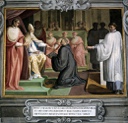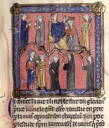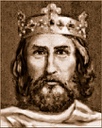

Généalogie and Heritage
Graphique personnel
Autres noms
| Autres noms | Nom |
|---|---|
| Nom de scène | pepin |
| Nom de scène | the Short King of France |
| Nom de scène | Pepin III King of Franks |
| Nom de scène | Pépin Le Bref |
| Nom de naissance | Pepin "The Short" III Of All Franks |
Parents
| Père | Date de naissance | Mère | Date de naissance |
|---|---|---|---|
 KARL 'Martel ' Herzog und Prinz der Franken KARL 'Martel ' Herzog und Prinz der Franken |
26/08/688 |  CHROTHRUDIS CHROTHRUDIS |
about 0690 |
Conjoints
Événements personnels
| Type d’événement | Date | Lieu | Description |
|---|---|---|---|
 Naissance Naissance |
0714 | Reich, Rhein-Hunsrück-Kreis, Rhineland-Palatinate, Germany | |
 Mariage Mariage |
about 0745 | ||
 Profession Profession |
from 0741 to 0751 | Austrasia | Mayor of the Palace of Austrasia |
 Profession Profession |
Mayor of Neustria | ||
 Décès Décès |
24/09/768 | France | |
 Inhumation Inhumation |
28/09/768 | Saint-Denis, Gard, France |
Caractéristiques
| Caractéristique | Description |
|---|---|
| Origine ethnique | Germanic |
| Numéro national d'identification | 2403 |
Notes
| Although Bertrada "married" Pepin in 741 and gave birth to their first child, Charlemagne, in 743, Pepin was already married at the time, to a woman named Leutberga, who was the mother of Pepin's five children. After 743, however, Leutberga either decidedto retire to a convent or was forced to do so. Even so, the marriage of Pepin and Bertrada was still not recognized--they were too closely related in order for their marriage to be legal. But for whatever reasons, the obstacle disappeared after 749, and Bertrada was recognized as Pepin's wife--although, as Nelson notes, political difficulties in 751 and 752 "may have driven [Pepin] briefly . . . to consider repudiating his wife Bertrada and marrying again." The two, Pepin and Bertrada, were consecrated as king and queen of the Franks in 754, after which Pepin was "a model husband." Unlike his famous son, he had no concubines and no illegitimate children. Pepin and Bertrada worked together to strengthen theirnew dynasty--"encouraging" Pepin's brother and nephews to pursue monastic, rather than secular, vocations, and consolidating the claims of their own sons, in particular that of their oldest son, Charlemagne. (Some sources indicate that Pepin and Leutberga's children were all sent off to monasteries.) After the death of Pepin in 768, his Frankish kingdom was divided between Charlemagne and his younger brother, Carloman, but Bertrada supported Charlemagne in opposing this division. The conflict between Charlemagne and his brother ended in 771, with Carloman's death. In the mean time, Charlemagne had "married" the Frankish noblewoman Himiltrude, probably before Pepin's death, and she gave birth to a son, also named Pepin, after his grandfather. The quotation marks I put around "married" when I describe Himiltrude's relationship with Charlemagne reflect some degree of uncertainty about their bond. |
| Pepin was not actually short; unlike peasants, aristocrats got enough food and were noticeably taller than most people. Moreover, northern Europeans were among the largest people in the world. Pepin is near-universally called ‘the Short’ in the Anglosphere due to a mistranslation of the French, “Pippin le Bref,” better translated as “Pepin the Brief.” Pepin ruled as King of the Franks for 17 years, which is hardly brief, but historians consistently measure Pepin against his father and son. Charles Martel ruled Francia as Duke and Princeps for 23 years, and his son Charlemagne ruled as king and later emperor for 46 years. |
| While Leutberga was married to Pepin he began an affair with Bertrada, daughter of the powerful Count Charibert of Laon, in what is today Aisne, France. Notably, her family founded and controlled the Prüm Abbey. It is possible that Pepin met Bertrada through work done with the abbey; we can’t be sure but there’s something delightfully devilish about an affair taking place in a Benedictine monastery. Pepin wanted to dismiss his first wife for her, which in and of itself would have been a scandal but to make matters worse, Bertrada was his second cousin. On 22 October 741 Charles Martel died, giving Pepin the chance to pursue his love…or lust, sometimes its hard to tell the two apart. Pepin dismissed Leutberga and sent their five children to a convent. The new Mayor of the Palace of Neustria had ceased loving her, if he ever did. Moreover, he needed to consolidate his power within Francia and so he married Bertrada while he was still married to Leutberga. |
| Pepin decided that if he were to become real king he had to change the nature of kingship itself. At that time kingship in Francia was based upon descent from Merovech, whose family, the Merovingians, had led their people for hundreds of years. Pepin was not a Merovingian, nor was he so powerful that he could rule through pure force. Pepin had to unite the nobles of Francia under some new paradigm they could agree to, and one which the Merovingians had no claim to. Pepin chose religion as the force that would enshrine his dynasty and unify the realm. Religion was the tool that Pepin and his father had used to administer Francia for decades and in the chaos of his youth devotion to Catholicism was the only commonality among the Franks and their vassals. In751 at Soissons the Mayor of the Palace inaugurated a whole new basis for rule: instead of sovereignty coming from noble privilege, Pepin claimed that God had chosen him as ruler. |
Sources
| Description | Référence/Commentaire | Qualité | Information | Preuve |
|---|---|---|---|---|
 Ancestral Roots of Certain American Colonists Ancestral Roots of Certain American Colonists |
Originale | Seconde main | Directe | |
 Britannica -Pippin III Britannica -Pippin III |
Originale | Seconde main | Directe | |
 Find a Grave: Pepin “The Short” of the Franks Find a Grave: Pepin “The Short” of the Franks |
Originale | Seconde main | Directe | |
 Foundation for Medieval Genealogy Foundation for Medieval Genealogy |
Originale | Seconde main | Directe | |
 New World Encyclopedia -Pepin the Short New World Encyclopedia -Pepin the Short |
Originale | Seconde main | Directe | |
 Pepin the Short Pepin the Short |
Originale | Seconde main | Directe | |
 Pepin the Short Pepin the Short |
Originale | Seconde main | Directe | |
 Royal Ancestry Bible - Emperor Charlemagne ancestral lineage Royal Ancestry Bible - Emperor Charlemagne ancestral lineage |
Originale | Seconde main | Directe | |
 Royal Index, University of Hull Royal Index, University of Hull |
Originale | Seconde main | Directe | |
 Wikipedia - Pepin the Short Wikipedia - Pepin the Short |
Originale | Seconde main | Directe | |
 Wikipedia (German) Pippin der Jüngere deutsch Wikipedia (German) Pippin der Jüngere deutsch |
Originale | Seconde main | Directe | |
 Wikipedia (Portuguese) Wikipedia (Portuguese) |
Originale | Seconde main | Directe | |
 Wikiwand -Holy Roman Empire Wikiwand -Holy Roman Empire |
Originale | Seconde main | Directe | |
 Wikiwand: Carolingian Dynasty Wikiwand: Carolingian Dynasty |
Originale | Seconde main | Directe | |
 Wikiwand: Pepin the Short Wikiwand: Pepin the Short |
Originale | Seconde main | Directe |
Médias
Photos

Catholic parish & monastery church of St. Alto & St. Birgitta in Altomünster in the district of Dachau (Bavaria), dome fresco (1728-1769).

Catholic parish & monastery church of St. Alto & St. Birgitta in Altomünster in the district of Dachau (Bavaria), dome fresco (1728-1769).

Pepin the Short, miniature, Imperial Chronicle (Anonymi chronica imperatorum), Corpus Christi College, fol. 14. circa 1112-circa 1114.

The donation of Pepin the Short to Pope Stephen II (or treaty of Quierzy), in 754, creates the Papal States.

Catholic parish & monastery church of St. Alto & St. Birgitta in Altomünster in the district of Dachau (Bavaria), dome fresco (1728-1769).
Histoire
| Date | Âge | Événement | Catégorie |
|---|















